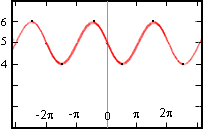Maxima
and Minima
We have seen previously that the sign of the derivative provides
us with information about where a function (and its graph) has stationary
points. We now look at local maxima and minima again.
Look at the applet below. Use the slider bar to change the value of x. Two examples
are given of higher order polynomials and you can enter other coefficients including
0, to totally convince yourself that:
- At all local maxima, f '(x) = 0 and f "(x) < 0.
- At all local minima, f '(x) = 0 and f "(x) > 0.
- At all points of inflection, f "(x) =
0.
Can't see the above java applet? Click here
to see how to enable Java on your web browser. (This applet
is based on free Java applets from JavaMath
)
This leads us to the preferred method for determining the local maxima or
minima for some function.
- Differentiate the function, f(x),
to obtain f '(x) and f "(x).
- Solve the equation f '(x) = 0 for x to
get the values of x at potential minima or maxima.
- For each x value:
- Determine the value of f "(x) at the x value.
- Decide if you have a minimum or a maximum.
- At all local maxima, f "(x) < 0.
- At all local minima, f "(x) > 0.
- If f "(x)
= 0, do the first derivative test.
- Calculate the value of the function at the x value.
Example
Consider the function f(x) = 5 - sin x.
Differentiating gives f '(x) = -cos x and f "(x) = sin x.
Solving f '(x) = 0 = -cos x leads
to x = -  or x = or x =  or generally x = nπ + or generally x = nπ +  where n is an integer. where n is an integer.
f "(x) = sin x, so f "(- )
= -1 and f(- )
= -1 and f(- )
= 6 so (- )
= 6 so (- ,6) is
a local maximum, recurring at every (2nπ − ,6) is
a local maximum, recurring at every (2nπ −  ,4). ,4).
f "( )
= 1 and f( )
= 1 and f( )
= 4 so ( )
= 4 so ( ,4) is
a local minimum, recurring at every (2nπ + ,4) is
a local minimum, recurring at every (2nπ +  ,4). ,4).

Consider f (x) = x4. f '(x) = 4x3, so f '(x) = 0 when x = 0. f "(x) = 12x2, so f "(0) = 0. If x) < 0 then f '(x) is negative and if x) > 0 then f '(x) is positive. f '(x) is increasing. This is a local minimum. f (0) = 04 = 0 giving (0,0) is the loacl minimum point.

Exercise
<< Concavity and Points of Inflection | Sign
of Second Derivative Index | Summary >>
| 
